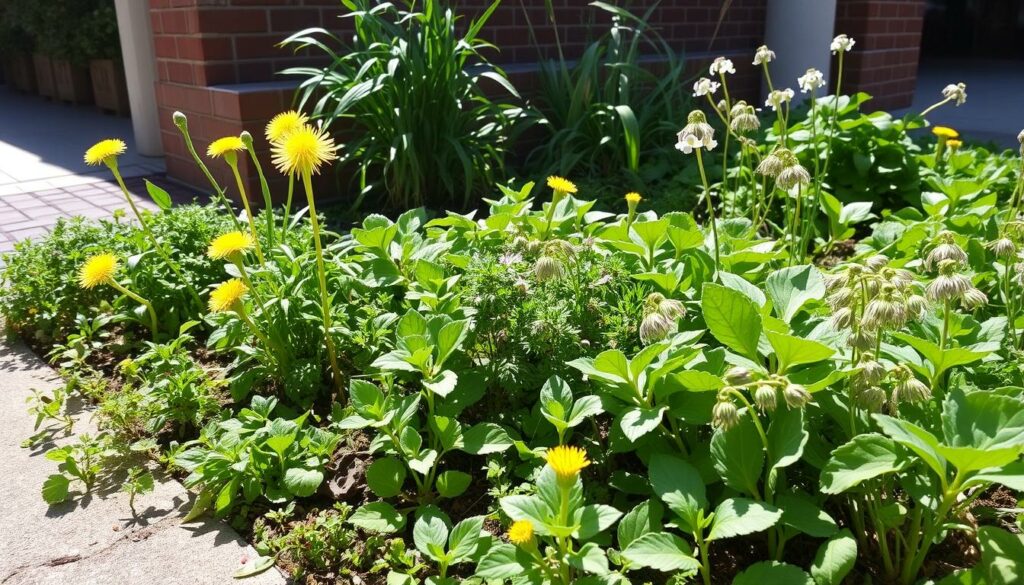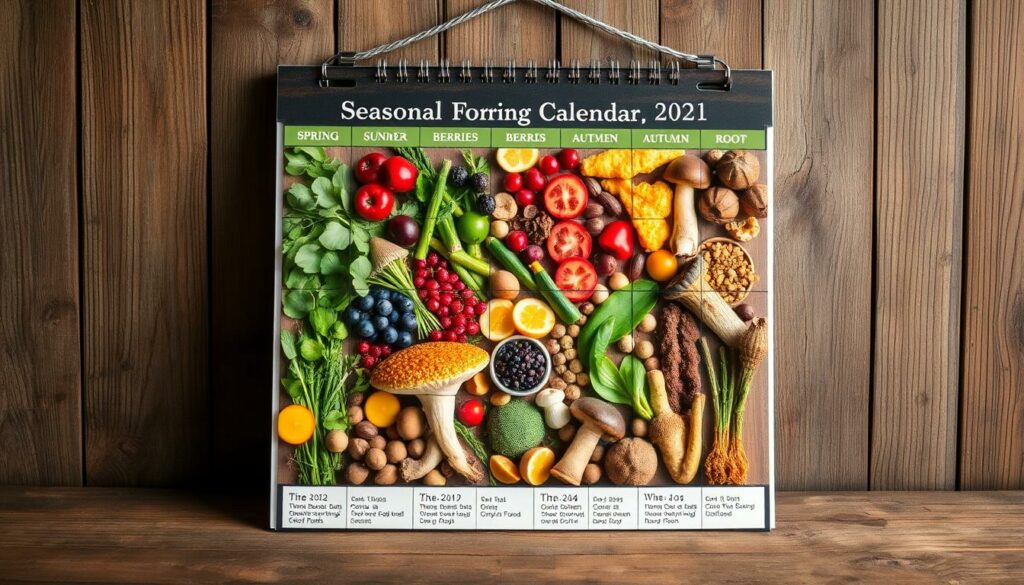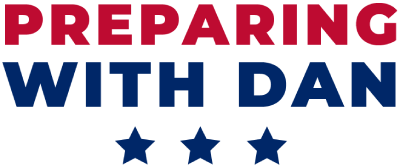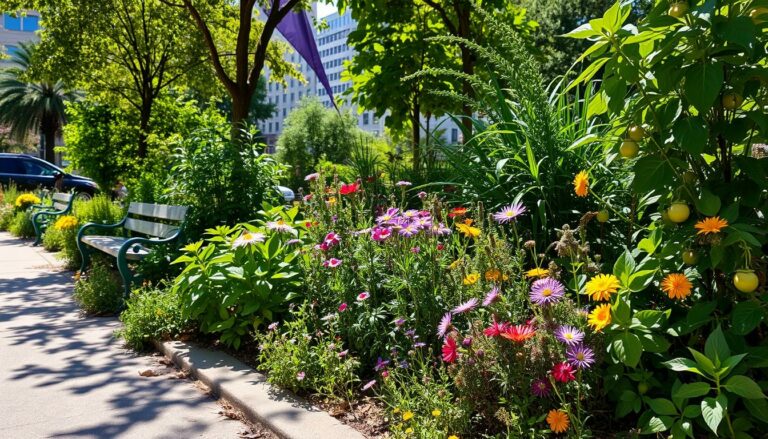Urban foraging is becoming popular in cities across the U.S. It’s about finding free food and edible plants in urban areas. People are discovering nature’s gifts right in their backyards.
A study by Melissa R. Poe and her team found that nearly 60 Seattle gatherers find deep meaning in urban foraging. They see it as a way to connect with nature, keep cultural traditions, and build community. The online map fallingfruit.org has marked over 550,000 foraging spots in North American cities.
Dave Odd, who has been leading foraging tours since 2010, shares exciting finds like white mulberries and serviceberries. He points out that common plants like dandelions can be used to make vegan honey and coffee. Even the humble plantain leaf serves as nature’s own first-aid kit.
Key Takeaways
- Urban foraging involves finding free food in city spaces
- Over 550,000 foraging spots exist in North American cities
- Foraging builds community and connects people with nature
- Common plants like dandelions have surprising uses
- Foraging tours offer hands-on learning experiences
- Always check local laws before foraging in public spaces
What is Urban Foraging?
Urban foraging is about finding and picking edible plants in cities. It mixes nature exploration with sustainable food finding right in our city yards. More people are into it because it helps them connect with nature and get fresh, local food.
Definition and Concept
Urban foraging means looking for and picking wild foods in cities. These can be fruits, nuts, herbs, and mushrooms. People go to parks, empty lots, and neighborhoods to find these foods. It takes knowledge, skill, and a good eye for plants.
Benefits of Urban Foraging
Foraging is more than just getting free food. It helps people connect with nature and understand local ecosystems. It teaches about native plants and their uses. This can make people healthier, build stronger social ties, and give a feeling of achievement.
| Benefit | Description |
|---|---|
| Nutrition | Access to fresh, nutrient-rich foods |
| Education | Learning about local flora and ecosystems |
| Sustainability | Reducing food miles and packaging waste |
| Community | Building social connections through shared activities |
Growing Popularity and Social Media Trends
Social media has made foraging more popular. Sites like Instagram and TikTok are full of people sharing their finds and recipes. This has made more young people interested in foraging. Influencers show how diverse urban foods can be, encouraging others to see their neighborhoods in a new way.
“Urban foraging helps us rethink our relationship with nature in cities, especially in the face of climate change.”
Getting Started: Essential Tools and Resources
Urban foraging lets you discover edible plants in the city. To start, you need the right tools and resources. Let’s look at the essentials for success.
Foragers use a variety of tools. Felco pruners are known for their strength. Hori hori weeding knives are essential, with a 25-year history. Japanese-style butcher knives are great for tough roots. A hand lens with 10x to 20x magnification helps identify plants.
Your foraging kit should include:
- Foraging bookbag
- Various storage bags
- Sunscreen and bug spray
- Compass and first-aid supplies
- Hori Hori tool and small hand saw
- Scissors and gloves
Wear long pants, boots, and a sun hat for success. Having a friend with you can make foraging more fun.
Identifying edible plants in the city needs the right resources. Field guides and ecology books are key. For those who prefer technology, apps like Wild Edibles and iNaturalist help identify plants on the go.
| Tool | Use | Durability |
|---|---|---|
| Felco Pruners | Cutting branches | 25+ years |
| Hori Hori Knife | Digging, cutting | 25+ years |
| Hand Lens | Plant identification | Varies |
Knowledge is crucial. Learn about local plants, the ecosystem, and ethical foraging before you begin. With the right tools and knowledge, you’re set to explore urban foraging.
Identifying Edible Urban Plants
Urban foraging is getting more popular, with TikTok videos on the topic getting over 72 million views. This shows how important it is to know which plants in the city are safe to eat. Let’s look at some common plants you can find in the city.
Common Edible Weeds
Many edible weeds grow in cities. Dandelions, often seen as weeds, have edible leaves, flowers, and roots. Lamb’s quarters are a tasty spinach alternative. Purslane, full of omega-3 fatty acids, is great for urban foragers.

Wild Berries and Fruits
Urban areas can surprise you with wild berries. Look for wild strawberries, mulberries, and serviceberries. These fruits are great in muffins, pies, and jams. But, make sure you know which berries are safe to eat.
Nuts and Seeds
In the fall, you can forage for nuts in the city. Black walnuts are easy to find and perfect for baking. Maple trees offer sap in spring for homemade syrup.
| Plant | Edible Parts | Common Uses |
|---|---|---|
| Dandelion | Leaves, flowers, roots | Salads, tea, coffee substitute |
| Lamb’s Quarters | Leaves, stems | Cooked greens, salads |
| Purslane | Leaves, stems | Salads, stir-fries |
| Wild Strawberries | Fruit | Fresh eating, jams |
| Black Walnuts | Nuts | Baking, snacking |
Foraging in the city can be fun, but always make sure you know what you’re picking. Double-check the plant’s identity before eating it. Use different sources to confirm and think about joining local foraging groups to learn from experts.
Urban Foraging Safety and Ethics
Urban foraging has become more popular, with U.C. Berkeley researchers seeing a big increase in social media posts about it in summer 2020. This rise shows we need to focus on safe and ethical foraging.
It’s important to pick foraging spots away from busy roads or polluted places. Choose clean, pesticide-free areas to make sure what you find is safe to eat. Always put safety first when foraging in the city.
Being ethical when foraging helps protect nature’s resources. Linda Black Elk, a food sovereignty teacher from the Catawba Nation, talks about sustainable foraging. She suggests picking invasive plants to help native ones grow. This is a good way to forage responsibly and care for the environment.
Karl Holl, the founder of Forager Goods & Co., says to leave foraging spots cleaner than you found them. Doing this shows respect for nature and keeps the area open for others to forage in the future.
“Know the best way to harvest each plant for sustainable impact,” advises Linda Black Elk.
Here are some key foraging tips:
- Avoid large groups to minimize environmental impact
- Don’t create new trails or trample plants
- Leave a portion of plants behind for regrowth
- Be aware of your surroundings and weather conditions
- Always get permission before foraging on private land
By following these tips, you help make urban foraging sustainable and enjoyable. Remember, ethical foraging lets us enjoy it now and in the future.
| Popular Foraged Items | Foraging Considerations |
|---|---|
| Morel mushrooms | Proper identification is crucial |
| Wild onion | Avoid harvesting near polluted areas |
| Garlic mustard | Invasive species, good for targeting |
| Stinging nettle | Wear gloves when harvesting |
| Dandelions | Easy to identify, widely available |
Best Locations for Urban Foraging
Urban foraging spots are hidden gems in cities. They range from lush parks to quiet neighborhoods. These places are full of edible plants for those who forage in the city. Let’s check out some top spots where nature’s pantry is waiting.
Parks and Green Spaces
City parks are perfect for foragers. Prospect Park in Brooklyn is a great example. It offers guided walks on edible and medicinal plants for $20-$40. These walks happen every other Friday from 10 am to 12 pm.
On these tours, you’ll learn about the uses of oak and linden trees. It’s a great way to connect with nature.
Vacant Lots and Fence Lines
Vacant lots and fence lines are often overlooked but can be full of wild edibles. You can find dandelions, chickweed, and purslane in these spots. The Falling Fruit website has an interactive map with over 500,000 foraging spots worldwide, including these hidden gems.
Neighborhoods and Backyards
Residential areas can be great for foraging too. Fruit trees often grow over public sidewalks, offering free fruit. In Pennsylvania, you can find mulberry trees. California has loquats and kumquats, while Wisconsin is known for apples, pears, and plums.
| Location | Common Foraged Items | Best Season |
|---|---|---|
| Parks | Wild garlic, rosehips | Spring, Fall |
| Vacant Lots | Dandelions, chickweed | Spring, Summer |
| Neighborhoods | Fruit trees, berries | Summer, Fall |
Always remember to forage ethically and know the local rules. Happy foraging!
Seasonal Guide to Urban Foraging

Urban foraging has its own rhythm, offering different plants throughout the year. A foraging calendar helps track the best times to pick various species.
Spring starts the foraging season. Young greens and wild herbs come out, great for fresh salads. At Fort Snelling State Park near Minneapolis, you can pick edible fruits and mushrooms for personal use in spring.
Summer brings berries and fruits to the city. Elderflowers bloom, marking the start of summer foraging. Later, elderberries get ripe, full of vitamin C. Edible roses, grown without pesticides, are versatile in cooking.
Fall is the best time for nuts, late fruits, and some mushrooms. It’s important to know your plants well, as some look alike. For example, three-cornered leeks and bluebells look similar before they bloom.
Winter foraging is about evergreen needles and bark. While there are fewer options, you can still find edible plants in the city during the cold months.
| Season | Edible Plants | Foraging Tips |
|---|---|---|
| Spring | Dandelions, Wild Garlic, Nettles | Blanch dandelion leaves for salads. Use gloves for nettles. |
| Summer | Elderflowers, Berries, Edible Roses | Harvest elderberries for vitamin C. Use rose petals in cooking. |
| Fall | Nuts, Late Fruits, Mushrooms | Learn to identify mushrooms safely. Collect fallen nuts. |
| Winter | Evergreen Needles, Bark | Focus on coniferous trees. Respect plant health when harvesting bark. |
Remember, foraging responsibly is crucial. Always check local laws and avoid contaminated areas. With planning and knowledge, urban foraging can be rewarding all year.
Legal Considerations and Regulations
Urban foraging has become more popular, but knowing the laws is key. Foraging laws change a lot across the U.S. So, it’s important to look up local rules before you start foraging.
Local Laws and Restrictions
Foraging rules vary a lot by state and city. For example, Arkansas and California don’t allow foraging on state lands. But Alaska and Hawaii are more open to it. In places like New York City, foraging in parks is banned and can lead to fines.
National Park Foraging Rules
The National Park Service has general foraging rules. But, each park can have its own rules. These rules change every year and can be found in the “Superintendent’s Compendium”.
| National Park | Foraging Regulations |
|---|---|
| Acadia National Park | Allows hand-harvesting of certain fruits and nuts for personal use |
| Joshua Tree National Park | Prohibits all foraging within park boundaries |
Ethical Harvesting Practices
When foraging legally, follow ethical practices. Only take a little, so there’s enough for wildlife and the future. This way, you enjoy nature while protecting it.
Foraging laws protect the environment and keep us safe. Always check the rules and get any needed permissions before you start. This makes foraging responsible and fun.
Urban Foraging: From Plant to Plate
Urban foraging opens up a world of culinary possibilities. With edible urban plants at your fingertips, you can create delicious wild food dishes right in your kitchen. Let’s explore some exciting foraging recipes that’ll transform your finds into mouthwatering meals.
Dandelion greens are great in salads or as a side dish when sautéed. Lambsquarters are perfect in soups and frittatas, adding a unique flavor. Wild mint is great for both savory and sweet dishes, making it perfect for teas and desserts.
Foraged berries are versatile. Use them in jams, pies, or homemade ice cream for a burst of natural sweetness. Black walnuts add depth to baked goods, bringing a rich, earthy flavor to your creations.
“Foraging involves gathering food that was not intentionally cultivated for consumption,” says Samuel Thayer, a renowned foraging expert.
Always clean and prepare your foraged foods properly before cooking. Many foragers share their favorite recipes online, providing inspiration for your wild food cooking adventures. Here’s a simple recipe to get you started:
| Wild Greens Salad | Ingredients | Instructions |
|---|---|---|
| A refreshing mix of foraged greens | Dandelion greens, lambsquarters, wild mint, olive oil, lemon juice, salt, pepper | 1. Wash greens thoroughly 2. Chop greens and mint 3. Toss with olive oil and lemon juice 4. Season with salt and pepper 5. Serve immediately |
Urban foraging brings nature’s bounty to your plate, offering fresh, organic ingredients for creative cooking. With practice, you’ll soon be crafting delicious meals from your foraged finds.
Preserving Your Foraged Finds
After foraging, it’s key to know how to store your finds. Proper storage can make your foraged items last longer. This lets you enjoy nature’s gifts even after the harvest season.
Drying and dehydrating
Drying is great for keeping foraged food fresh, like herbs and leafy greens. Kate Armstrong, a pro forager since 2009, suggests using a food dehydrator or hanging herbs in a dry spot. This method is perfect for wild peppermint, dandelion leaves, and stinging nettles.
Freezing techniques
Freezing is best for berries and some greens. Andy Conner, from Foraged, recommends freezing berries on a tray before putting them in containers. This keeps their shape and taste. You can also freeze leafy greens like lamb’s quarters for soups or smoothies.
Canning and preserving
Canning is great for making jams, jellies, and syrups from foraged fruits. Urban foragers can turn wild apples, plums, and elderberries into tasty preserves. Just remember to can safely to keep your food safe. These tips will help you enjoy your urban harvest all year round.
Source Links
- https://www.biophiliccities.org/urban-foraging
- https://www.wbez.org/environment/2024/08/27/the-strange-wild-art-of-urban-foraging-and-how-to-do-it-yourself-in-chicago
- https://www.cnn.com/2023/05/02/health/urban-foraging-wellness-scn/index.html
- https://academic.oup.com/jue/article/5/1/juy028/5303355
- https://www.mdpi.com/2071-1050/9/10/1884
- https://chestnutherbs.com/essential-foraging-tools-and-supplies/
- https://thedruidsgarden.com/2015/01/18/introduction-to-wildcrafting-and-foraging-part-i-equipment-resources-what-to-learn-and-timing/
- https://imaginacres.com/urban-foraging/
- https://mashable.com/article/how-to-start-urban-foraging
- https://utopia.org/guide/urban-foraging-how-what-to-harvest-in-city-environments/
- https://www.fieldmag.com/articles/sustainable-ethical-foraging-guide
- https://www.budgetsavvydiva.com/2023/07/urban-foraging-a-comprehensive-guide-to-exploring-natures-bounty-in-your-city/
- https://brooklynbased.com/2019/10/22/urban-foraging-gathering-ground/
- https://www.nationalgeographic.com/travel/article/how-urban-foraging-became-the-new-way-to-explore-a-city
- https://www.npr.org/sections/thesalt/2013/04/23/178603623/want-to-forage-in-your-city-theres-a-map-for-that
- https://www.fourseasonforaging.com/urban-foraging
- https://www.olivemagazine.com/guides/how-to/urban-foraging-guide-how-to-forage-in-cities-in-spring-and-summer/
- https://thecounter.org/the-case-for-legalizing-foraging-in-national-parks/
- https://ir.lawnet.fordham.edu/cgi/viewcontent.cgi?article=2740&context=ulj
- https://subarudrive.com/articles/a-beginners-guide-to-responsible-foraging-AugOE19
- https://learn.surlatable.com/what-is-urban-foraging/
- https://slowfoodusa.org/event/fed-workshop-how-to-urban-foraging/
- https://www.theselfsufficienthomeacre.com/2021/04/how-to-find-free-food-by-urban-foraging.html

